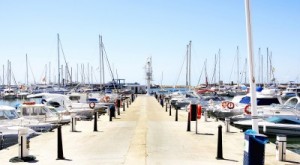 Docking is tricky business. Many boat captains listen to those so willing to offer docking advice. There is only one person solely responsible for your vessel and crew safety: you. Even the most experienced captains and crews have a little pre-docking briefing. Managing the crew and its assigned tasks prior to and during docking is one of the most important things to get a handle on. Go over each crew member’s responsibility precisely do this in advance of docking maneuvers. Also decide who should remain seated and out of the way until the lines are secure. Make sure that everyone is aware of your expectations through every stage of docking. Who handles the bow, the stern, and the spring lines? Who deploys fenders?
Docking is tricky business. Many boat captains listen to those so willing to offer docking advice. There is only one person solely responsible for your vessel and crew safety: you. Even the most experienced captains and crews have a little pre-docking briefing. Managing the crew and its assigned tasks prior to and during docking is one of the most important things to get a handle on. Go over each crew member’s responsibility precisely do this in advance of docking maneuvers. Also decide who should remain seated and out of the way until the lines are secure. Make sure that everyone is aware of your expectations through every stage of docking. Who handles the bow, the stern, and the spring lines? Who deploys fenders?
An important thing to remember is to be sure to always stress safety first: no hands between bulkheads, seawalls and pilings, and make sure that mooring lines aren’t wrapped around hands, legs or feet.
So what do you do as you approach your docking destination? Call on the marina’s dedicated channel before approaching the harbor. Stop outside the harbor to position the fenders. Have a notepad ready before calling the harbor master. Be honest about your experience about docking. The first line to toss is your spring line with loop fed through your boat’s cleat. Loosely coil lines, making sure there are no tangles, then toss them gently to the dock staff. Make sure the lines are at least the length of your boat. Use boat hooks to retrieve lines dropped in the water, or the opposite end of the hook to fend off other boats when a bump is anticipated.
Current and wind are the two influential factors when you are docking, and each force is directed at a different part of the boat. To expertly and safely dock a boat you should be familiar with the effects of both and how to predict your boat’s response to each of these factors. Once you are familiar with the affects of wind and current docking will be a lot easier.
The first step in preparing to dock is to judge the external factors you just learned about. Your analysis will determine how fast and at what angle you approach the dock. If the wind is blowing towards the dock you will want to steer a course further away from the dock and allow the wind to move you in. If the wind or current is on your stern you will want to go in more slowly and plan to shift into reverse earlier to halt your forward motion
Source: “Tips for New Boat Owners-How to Dock a Boat”, Essortment.com, 14 November 2012.Web
Follow Us: Facebook – Foursquare – Twitter – YouTube – LinkedIn
